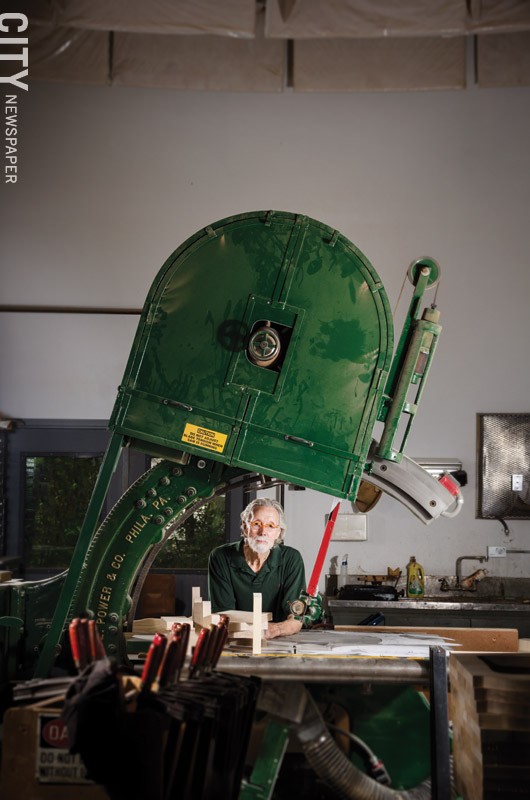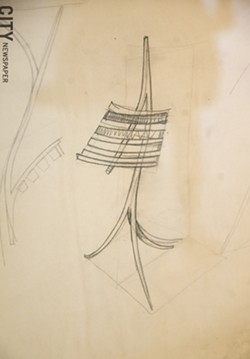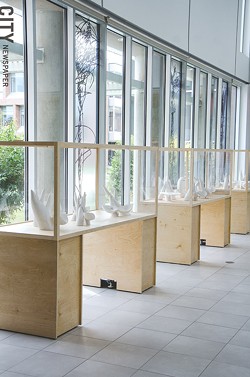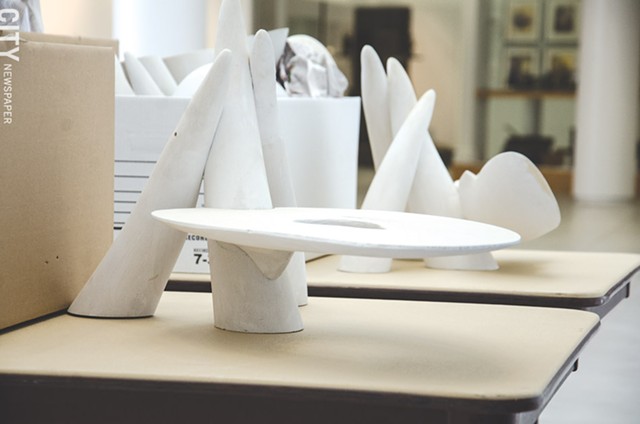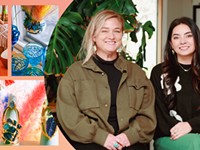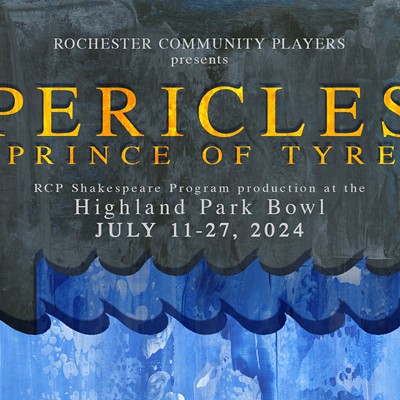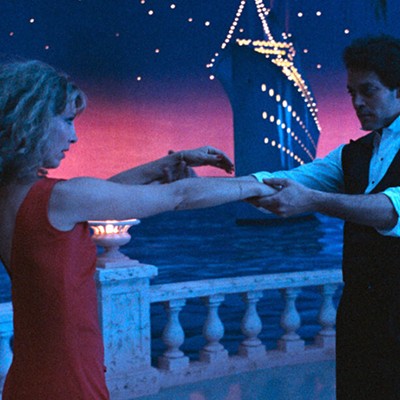
[
{
"name": "500x250 Ad",
"insertPoint": "5",
"component": "15667920",
"parentWrapperClass": "",
"requiredCountToDisplay": "1"
}
]
While Wendell Castle has incorporated modern technology into making his sculptural furniture, the storied artist still starts with pencil and paper
Of all of the studio's tools, analog or digital, the pencil is still Wendell Castle's favorite. To him, drawing is discernment. His love for the tactile nature of making marks is palpable; his description of the weight of the hand-drawn line borders on the romantic. And while he's incorporated certain aspects of the digital age to aid in the creation of his monumental, sculptural furniture, he adamantly maintains the human touch of his craft. This month, "Wendell Castle Imagined: A Revelation of Creative Process" opens at the University Gallery (at Rochester Institute of Technology, where Castle is an artist in residence).
With a career spanning more than 50 years, Castle is widely spoken of as the pivotal figure of the Craft Furniture Movement. RIT's exhibition of dozens of drawings and scale models from throughout his career provides an insight into his methods and unique aesthetic, and there's an emphasis on the processes and philosophic thought that characterize his internationally recognized artistry.
At 84, Castle has the sage nature that his years have earned, and the energy of a much younger man. He keeps his slight frame honed for labor with bi-weekly games of tennis, and has a collection of vintage sports cars that bear him around in style.
When asked to further illustrate an idea he's discussing, he's quick to jump up and retrieve a model from another room of his labyrinthine workspace. He operates his Scottsville studio like an old-school workshop, with assistants learning from their master-craftsman employer. And the production of tables, chairs, and benches inside his studio can't keep up with his idea output.
Even as he oversees the various stages of production of about a dozen works at once — some of which are bound for his New York City gallery when complete, while other full-scale models will be shipped to the foundry at his Paris gallery to be cast in aluminum — he's eager to begin production on several drawings and models he's worked up for a 2018 show in Kansas, his home state.
In-progress projects include a long, leaf-shaped table top supported by metal cantilevers hidden inside a cluster of monolithic stalagmite-like forms on one side of the surface. Another work is a smaller table made of a cluster of oblong ellipses that are evenly truncated at the tops to create a series of plateaus.
A two-person chair has a square-shaped hole in the back of one seat. When asked about the cut out, Castle is elusive. "If there was any continuity and logic in there, I wanted to throw that outta whack," he says. "There is no reason."
Many of Castle's current creations tend to hold space hostage. For example, a newer design includes a seat and small table surface that subtly emerge from one side of a solid block of wood. This block will be made of a laminated stack of planks, but refined to a finish that hides that fact.
"Generally speaking, larger is more powerful — not always, but often," Castle says. "As soon as you start making your work larger, you're narrowing your audience by a great deal. I do it anyway, and that's not logical. But art isn't logical, and I'm more interested in things that have to do with art than with useful design."
Castle is fascinated by the concept of intellectual bafflement. "Something that you don't immediately understand at first glance makes you think about it," he says. "And I think it's really important — to make people think about it: 'What is this, and why?' — that those are not givens, not obvious."
Some of his work may not even be perceived as furniture if approached from the back, Castle says. "Even when the object is identified as a chair, you might think, 'Why would anybody do that?' But I think that's a really important part."
Inside the studio with Wendell Castle from Alex Freeman on Vimeo.
Castle is a highly contemplative, particular man. His candor is thoughtfully measured and soft in tone. He carefully takes everything in from behind his iconic small, round, colorfully-framed spectacles.
"Talking is thinking," he says. "Questions are really important — how you phrase the questions. I'm careful. I would never go to someone, whether it was my dealer or a person in the shop, and say, 'I've got this great idea. What do you think?' You are not going to get an honest answer."
People phrase questions knowing that they want a certain answer, he says. You might get the answer that you wanted, but you didn't learn anything.
"I put critical thinking at a very high level, right from the beginning," he says. "When you're all done drawing, and you lay out the drawings to make decisions, deciding what piece to do, that's a whole process."
Which drawing looks the best is only one point in the list of criteria, he says. "You have to consider, 'is this in keeping with how I think about things, from the beginning, or is this some kind of outlier thing, that really doesn't seem to have much to do with what I've been trying to say for years?'"
Then he considers whether the idea has legs — can it be interpreted and flow into new ideas, or will it be a dead end? "If that's it, I wouldn't do it," he says.
Castle puts his drawings through those questions long before he carves out miniature urethane models of the future furniture. "I really do want to weigh things without my thumb on the scale — which is so easy to do," he says. "But it doesn't mean that in the end it will be successful just because it meets all of the criteria."
He says that in different points of his career, he's taken chances in directions that people did not expect from him, and some of these directions have been successful. "Except it was not rewarding to me," he says. "The most important thing is that it needs to be rewarding to me."
One such instance was his flirtation with trompe l'oeil sculpture in the 1970's and 80's.
"From the very beginning I wanted to raise furniture to the level of a fine art," he says. "The question was how to do that. The early thought — and I think I was correct — was to use sculpture as vocabulary. But at some point, I began to wonder, 'Is there another way?'
His interests settled on trompe l'oeil due to the genre's uncontested association with fine art. But he still needed to connect that aesthetic to furniture, "because that was where I was going to make my mark," he says. "So what I carved were an umbrella in an umbrella stand, a coat hanging on a coat rack, a purse lying on a table, things like that."
These works were executed successfully — a sculpture of a chair balanced upside down on a pillow is perfectly realistic, as if the weight of the chair is pressing into a downy cushion. And many pieces found homes in public and private collections.
Castle is particularly critical of his trompe l'oeil works' elements of furniture. "I really didn't make a unique design, I borrowed from historical examples," he says, "the reason being that trompe l'oeil work looks like every day recognizable things. If you made it with funny looking furniture or objects, it wouldn't work. It works because your brain does not need to study things you're familiar with to know what it is. There is no real use of your brain, just instantly you think you know what you're looking at."
He says he initially took up the technique for a challenge, since the carving would have to be so well done. "I was also determined not to use color, and it still fooled people," he says. "But the problem was, that once you've figured out this formula, what's the fun in doing it? Once I knew what worked, I didn't want to do it anymore."
Dead ends in discovery are to be avoided at all costs. But through much trial and error, Castle has become adept at predicting which avenues will lead to an under-stimulating impasse.
"I did not know anything about art as a child," Castle says. "In none of my early childhood education were there any art classes." He attended a small rural school in Kansas where art wasn't even offered in high school.
"Art had never occurred to me as a thing I could do," he says. "I did draw as a child, a lot. But my drawings were not valued, and none were saved."
His tone becomes wistful as he recalls the limitations of his childhood. "I wasn't particularly good at anything," he says. "I was a very average student, and I'm dyslexic, so that made school very difficult."
Castle says he was "more or less sent" to a small liberal arts college, where he had the chance to take an elective, and chose the only art course. "For the first time in my life, I was the best one in my class," he says with a warm smile. Recognizing his talent, the professor suggested that he switch to a school with a good art program.
Though his parents did not support this decision at the time, he says they reconciled with his career choice "50 years later, but gradually. There wasn't a specific moment that they recognized that what I was doing was legitimate, that I was successful at it," he says.
While attending art school, Castle had no intention of making furniture. Instead, he developed an interest in sculpture, "although I had no idea what my vocabulary should be," he says. "So I'm a reluctant furniture maker. But I recognized, at some point a year or two after completing my master's degree that I could use exactly the same thought process and exactly the same way of working, and it would be furniture instead of sculpture."
He says that he rationalized that he wasn't abandoning a superior art form, and would make furniture that could be as highly valued as sculpture.
In a corner of Castle's studio there is a series of architect's flat files containing sketches that if stacked, would be about 10 feet tall. There are two closets in the programming room that are also packed with drawings. A pencil and paper have been constant companions.
Castle doesn't wait on magical fits of inspiration to get started. "I put pencil to paper sometimes with no idea," he says.
He says he's experienced "eureka!" moments, "but they've never been any good. The only ones that have ever been good are the ones I've worked very hard at, and drew them many ways. I'll draw the piece over and over again, because I think I'm learning something while that activity is happening."
But more often than not, his new drawings are an extension of something else. "Because what you see as you're making something, often, is that there would have been another way to go," he says. "But I don't stop midstream, I finish what I started, because it may not have been a better idea. It's hard to know."
The hand-carved model stage is an important component, he says, because "it verifies. Once you have a drawing that has passed that test, answering all of these questions, the next stop is the model."
The model gives more information about the piece — it's front, back, and side views, and the particularities of texture — bringing together how the entire piece works out in three-dimensional space.
When this stage is complete, the model is 3D scanned, preserving each little nuance of the artist's hand.
Though he's added digital technology to aid in realizing his designs, Castle does not design on the computer.
"The computer wants to fix what it perceives as mistakes," he says. "If your design has a big curve, and all of a sudden there's a little blip in it, the computer would fix that."
Castle speaks strongly about the "direct connection between the pencil and the brain. I think drawing and thinking really mesh, and with the computer, there's a distance between them," he says.
He cites the work of late architect Zaha Hadid as an example of how others have used technology in a way he chooses to avoid. "You can just tell that was all designed on the computer," he says.
But due to our cultural obsession with technological capacities, Castle is finding that the sketchbook is being forsaken. "I'm finding that students today can't draw," he says, openly frustrated by the idea.
"It's a language to communicate with people in the studio," he says. "If someone says, 'What do you think of this idea?' or 'How do you think we should build this?' but they have drawn it in poor perspective, there's no point in discussing it."
Castle says he thinks that schools are contributing to illiteracy in draftsmanship as technology takes over, with curricula's increasing emphasis on computer skills. "The computer will do a lot of things that drawing can't do," he concedes, "but it can't do the very basic thing of working at an idea, and deciding if it's a good idea."
"And think that drawings have personality," he says. "Now that may not be very important in making a product, but it resonates with me, that the drawing is drawn in a way that I like, with line weights that I like. That I have a certain signature about the way I draw."
For Castle, technology only enters the equation when the model is 3D scanned and a code is created to make a tool path for his studio's 5,000-pound, room-sized robot, which is outfitted with a router and nicknamed Mr. Chips. Once stacks of planks have been laminated for a specific piece, it's the robot's job to mill the basic forms of the piece down the stack. Castle uses the technology to more perfectly pick up and retain the elements of human touch.
"We get all of these imperfections, which I want," Castle says. "By the time it gets to the computer, the creative process is essentially over," save for a few occasional tweaks. "We've narrowed it down to the most difficult — and in many cases impossible — woodworking tasks," he says.
For example, many of his tables and chairs have conical or elliptical legs, with compound curves that nestle perfectly against one another. The robot is able to rout the stacked wood into forms that are perfectly flush with one another. Through hand carving, he says, "all you'll ever know, unless you have x-ray vision, is how it fits on the outside."
Castle works primarily with ash because it's a hard wood and resists scratching, and has an open grain. Before applying stain or varnish, the surface is often wire brushed to further open up the grain and show off the natural, undulating patterns. And though its future is dubious thanks to the Emerald ash borer beetle, ash is currently readily available in knot-free high quality.
Unlike many high-end furniture makers, Castle doesn't have a catalog that patrons can select from to order; when he's done with an idea, he moves on.
"I joke about it and say I have a short attention span, but it's partly true," he says. "I really don't want to do the same thing over and over again. I like to have an idea and do it in various ways, but even that isn't going to last more than a couple of years. It's time to change it somewhat. Not drastically, so that no one would recognize it as my work, but change it."
Speaking of...
Latest in Art
More by Rebecca Rafferty
-

Beyond folklore
Apr 4, 2024 -

Partnership perks: Public Provisions @ Flour City Bread
Feb 24, 2024 -

Raison d’Art
Feb 19, 2024 - More »
